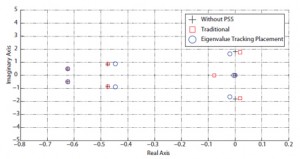Tracking of Unstable Eigenvalues
Rodney Yeu with adviser P. W. Sauer
A common problem in modern power systems is low-frequency oscillations that can lead to instability. The solution is to add a power system stabilizer (PSS) to one or more of the affected generators to damp out the unwanted oscillations. However, a power system may have 1000 generators. How does one decide where to put the PSS? Traditionally, this is done by looking at the eigenvalues of the linearized power system and performing a sensitivity analysis to determine which states participate the most in the critical mode instability. Then a PSS is placed at the machines with those states. In this research a new method for the placement of PSS was developed which tracks the eigenvalues of the power system as it is being decoupled to a system of single-machine infinite buses. The mode associated with the single machine tracks back to the unstable mode of the power system to determine where the PSS should be placed.
The eigenvalue tracking method has been tested on different power system cases and has shown that it could determine a better site for PSS installment than the sensitivity methods. As an example, for a particular power system the eigenvalue tracking method concluded that unstable eigenvalues were associated with machine 1. This association can be seen in Figure 35 and from this it is determined that the PSS should be installed in machine 1. The traditional sensitivity method determined that the PSS should be installed at machine 2.
The resulting eigenvalue after PSS installation at each machine is shown in Figure 36. From this figure it is clear that the eigenvalue tracking method led to better PSS placement. The eigenvalue tracking method will be further tested on different systems, and a method to tune a PSS stabilizer using the information from the eigenvalue tracking method will be investigated.
This work is supported by Grainger Endowments.

